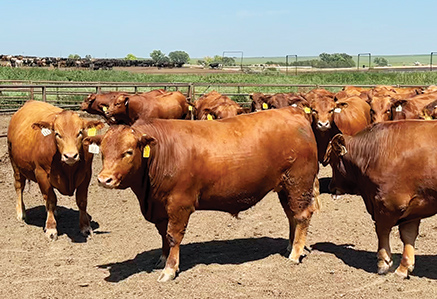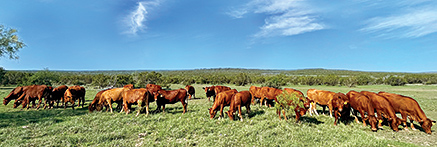
From the Fall 2025 issue of the Isa Informer
By Lorenzo Lasater, President
We’ve all heard the rancher bragging at the coffee shop—we’ll call him Mr. Coffeeshop—about how much his black calves brought per pound. The American Angus Association has done an excellent job convincing the U.S. calf-raiser that price-per-pound is the end of the story. But we need quite a bit more context to understand the impact on a bottom line.
In August, steers at Producers Auction in San Angelo, ranging from 400–600 pounds, averaged $4.04 per pound (Hallelujah!). The highest calves brought a whopping $4.26. Let’s assume Mr. Coffeeshop topped the market on his 495-pound, straight-Angus calves. He killed it right? Actually, Mr. Heavycalf, who brought in heavier calves, did much better in terms of gross income. Let’s assume Mr. Heavycalf’s Beefmaster x Angus calves averaged 70 pounds heavier and got the market average. You can see that he received $174 per head more for his heavier calves. So Mr. Coffeeshop can brag he got 0.22 cents per pound higher, but that is not the whole story.
One critical piece of information missing in this example is the percentage of calf-crop weaned. Were Mr. Coffeeshop’s cows hardy and adaptable enough to breed in a short season with minimum inputs? Were they good enough mothers to raise a big calf and industrious enough grazers to travel and use all the available forage to provide the milk needed? We all know a small variance in pregnancy rates and losses post-birth can make a tremendous difference on the bottom line.
Another important component to consider is cost per calf: A low-input operator uses the tools nature provides to raise calves for the lowest possible cost. The difference between the cost to raise that calf and the price you receive at market is what you take home. The difference between high- and low-cost operators can swing dramatically, ranging between $600 and $2200. This historically high market—when everyone had better be profitable—obscures inefficiencies somewhat, but even now if your cost is $2200 per calf, you are wasting your time.
What about percentage of culls? Mr. Coffeeshop failed to mention that he had 10 dogies (orphans) on his 100 calves, and they brought half as much. What if, through the genetics of mothering ability, Mr. Heavycalf only had four culls?
Mr. Coffeeshop would be quick to say that his fancy Angus calves will make better feeders. I don’t agree with that—and I’ll explain why shortly—but I would point out that most calf-raisers in America sell their calves at weaning. Obviously, we want to raise the best beef calves possible, but if our profitability is governed by the dollars we receive at weaning, shouldn’t we place the most emphasis on the things we can control at the ranch level to maximize those pounds?
Now let’s address the feeder calf issue: When I talk to someone who is considering using Beefmaster bulls to improve his calves (Mr. Bullbuyer), he will first ask: 1. Will they grade? and 2. Will they color-up my calves? I am pleased to report that we have worked for generations to eliminate off-colors, while also striving to make our cow herd more consistent in every way. But quality grade remains on everyone’s mind. When I began my career 33 years ago, cattle graded 50% Choice. Today, they top 84%. Our industry has done a remarkable job improving the quality of our product in terms of grade, uniformity and tenderness. In 2023 Isa Beefmaster fed three pens of steers in one Kansas feedyard. They were all L Bar genetics on either black or Red Angus females. To answer Mr. Bullbuyer’s grade question: They graded 86% Choice. One pen even graded 94% Choice. You can see more of the data in the news section of our website.
Is quality grade all there is to feedyard profitability? Heck no! Factors such as conversion, gain, sickness and death loss all make a significant impact on profitability in the yard. At slaughter, yield grade, waste fat and cull carcasses play as an important a role as grade in a grid. L Bar Beefmasters excelled in all those areas in the three pens I referenced, with a daily gain of 3.9, dry matter conversion of 5.6, death loss of 0.83%, and yield grade of 3.2. Ironically, 22% even qualified for CAB.
 Beefmaster x Red Angus steers in Kansas. Three Beefmaster-cross lots graded between 86% and 94% Choice and beat industry averages on daily gain, death loss and yield grade.
Beefmaster x Red Angus steers in Kansas. Three Beefmaster-cross lots graded between 86% and 94% Choice and beat industry averages on daily gain, death loss and yield grade.You may wonder why I keep referencing Angus. Estimates place the U.S beef cow herd at more than 80% Angus-influenced. That is a lot of black cows, and many are high percentage Angus, meaning they are not enjoying the tremendous (and free) benefits of heterosis. I would also say they are often not properly matched to many of the harsher environments in the southern United States. These can be characterized by intense heat and humidity, high insect loads, low-quality forage and big range to cover. It takes a special kind of female to excel in these circumstances. I compete to sell bulls, and to me, the obvious opportunity lies in ranchers who have Angus cows that are not getting the job done outside of the coffee shop.
I referenced heterosis earlier, which means the improvement in the performance of crossbred animals over their purebred parents. Also known as hybrid vigor, it affects many traits, such as reproductive performance, longevity, health, adaptability, growth and carcass traits. The great news is you can enjoy all these improvements for free. However, you must be able to look beyond coffee-shop talk in your operation. As the U.S. cow herd has become increasingly higher-percentage Angus, those heterosis advantages have eroded. But they can be added back in one generation—just by switching bulls. You can choose from many breeds, but I firmly believe Beefmasters are the right choice for any type of cow, for the myriad reasons I’ve explained here.
 These beautiful Beefmaster replacement females are as good as gold!
These beautiful Beefmaster replacement females are as good as gold!On the ranch, what is the biggest advantage of crossing Beefmaster bulls on the breed of your choice? The replacement females! Our industry constantly overlooks the importance of functional, productive cows. The idea that females (the factory) are worth less than their steer mates (a commodity) is absurd—that is, unless they are terminal animals, which I believe Angus have become. By harnessing the power of heterosis through crossing Beefmaster bulls on English-type cows, a rancher can improve the many characteristics I’ve mentioned, without harming others.
We know we can raise bigger calves and sell more pounds at weaning, but what if we could design females that can truly do more with less? The industry is overrun with 1500# corn-eating cows. We need more moderate females that can do their job on grass, in tough environments. What if their mothering ability far outpaced the other breeds and crosses? What about lifespan? Mr. Bullbuyer initially called because his Angus cows were falling out of the herd after four or five years. We need females with more longevity because every calf she can raise after age five is pure profit, and that longevity can expand within your gene pool through selection.
Beefmaster founder Tom Lasater famously said, “Cattle breeding is a relatively simple endeavor. The only difficult part is to keep it simple.” Today, raising beef calves has become a complex and difficult job because we often lose sight of the fact that we are paid for pounds at weaning and should laser-focus our efforts on improving that. I believe the industry needs to embrace a balanced approach in terms of genetic selection—one that maximizes pounds at weaning while optimizing the factory with efficient, functional females. With Beefmasters in a well-planned cross-breeding program, we can achieve both goals.
Download the Fall 2025 Informer here
© ISA BEEFMASTERS 1996-2024 ALL RIGHTS RESERVED.